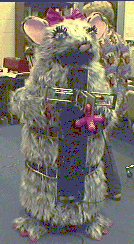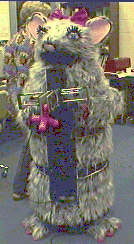N.D. Daw, A.C. Courville, and D.S. Touretzky (in press) Timing and partial observability in the
dopamine system. In S. Becker, S. Thrun, and K. Obermayer (Eds.),
Advances in Neural Information Processing Systems 15.
Cambridge, MA: MIT Press.
N.D. Daw and D.S. Touretzky (2002) Long-term reward
prediction in TD models of the dopamine system. Neural
Computation, 14(11), 2567-2583.
D.S. Touretzky, N.D. Daw, and E.J. Tira-Thompson (2002) Combining configural and TD learning
on a robot. Proceedings of the Second International Conference on
Development and Learning, pp. 47-52. Cambridge, MA, June 12-15. IEEE
Computer Society.
N.D. Daw, A.C. Courville, and D.S. Touretzky (2002) Dopamine and inference about timing.
Proceedings of the Second International Conference on Development and
Learning, pp. 271-276. Cambridge, MA, June 12-15. IEEE Computer
Society. gzipped Postscript)
- A.C.Courville and D.S. Touretzky. (2002) Modeling temporal structure in
classical conditioning. In T. Dietterich, S. Becker, and
Z. Ghahramani (Eds.), Advances in Neural Information Processing
Systems 14. Cambridge, MA: MIT Press. (gzipped Postscript)
- N.D.Daw and D.S. Touretzky (2001) Operant behavior
suggests attentional gating of dopamine system inputs.
Neurocomputing, 38-40:1161-1167.
- Daw, N. D., and Touretzky, D. S. (2000) Behavioral
considerations suggest an average reward TD model of the dopamine
system. Neurocomputing, 32:679-684.
- L.M. Saksida, S.M. Raymond, and D.S. Touretzky (1998) Shaping robot behavior using principles
from instrumental conditioning. Robotics and Autonomous
Systems, 22(3/4):231-249.
- D.S. Touretzky and L.M. Saksida (1997) Operant conditioning in
Skinnerbots. Adaptive Behavior 5(3/4):219-247.
- Saksida, L.M. and Touretzky, D.S. (1997). Application of a model
of instrumental conditioning to mobile robot control. In: Paul
S. Schenker and Gerard T. McKee (Eds.) Sensor Fusion and
Decentralized Control in Autonomous Robotic Systems. SPIE
vol. 3209. pp. 55-66.
- D.S. Touretzky and L.M. Saksida (1996) Skinnerbots. In P. Maes, M.
Mataric, J.-A. Meyer, J. Pollack, and S. W. Wilson (eds.), From Animals
to Animats 4: Proceedings of the Fourth International Conference on
Simulation of Adaptive Behavior, pp. 285-294. Cambridge, MA: MIT
Press. Postscript.
-
 Robots trained to think like
rats-honest. Pittsburgh Post-Gazette, Monday, Dec. 23, 1996, pp. A14-15.
By Byron Spice. Online version.
Robots trained to think like
rats-honest. Pittsburgh Post-Gazette, Monday, Dec. 23, 1996, pp. A14-15.
By Byron Spice. Online version.
 The Skinnerbots Project
The Skinnerbots Project

 The Skinnerbots Project
The Skinnerbots Project

 Robots trained to think like
rats-honest. Pittsburgh Post-Gazette, Monday, Dec. 23, 1996, pp. A14-15.
By Byron Spice. Online version.
Robots trained to think like
rats-honest. Pittsburgh Post-Gazette, Monday, Dec. 23, 1996, pp. A14-15.
By Byron Spice. Online version. 